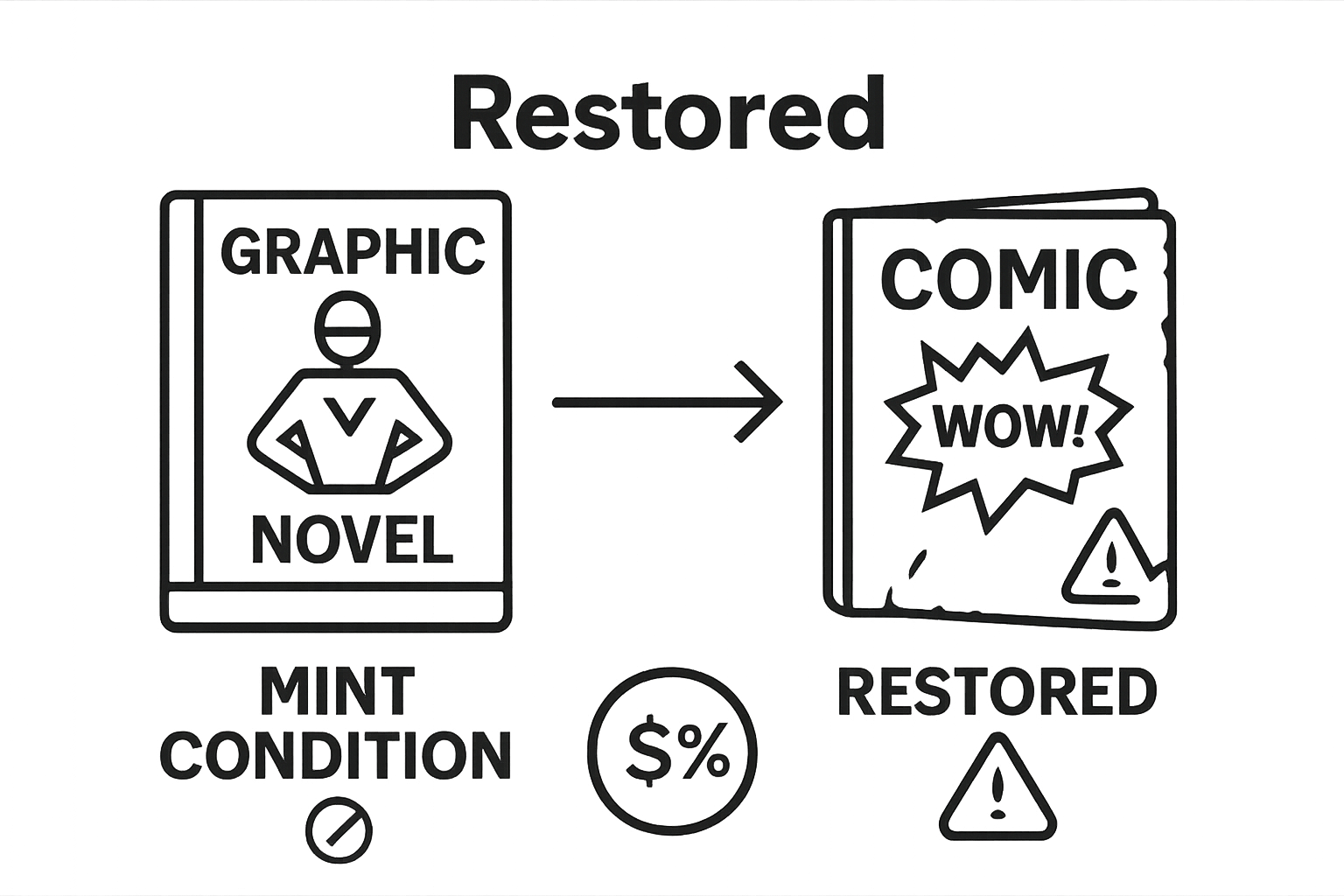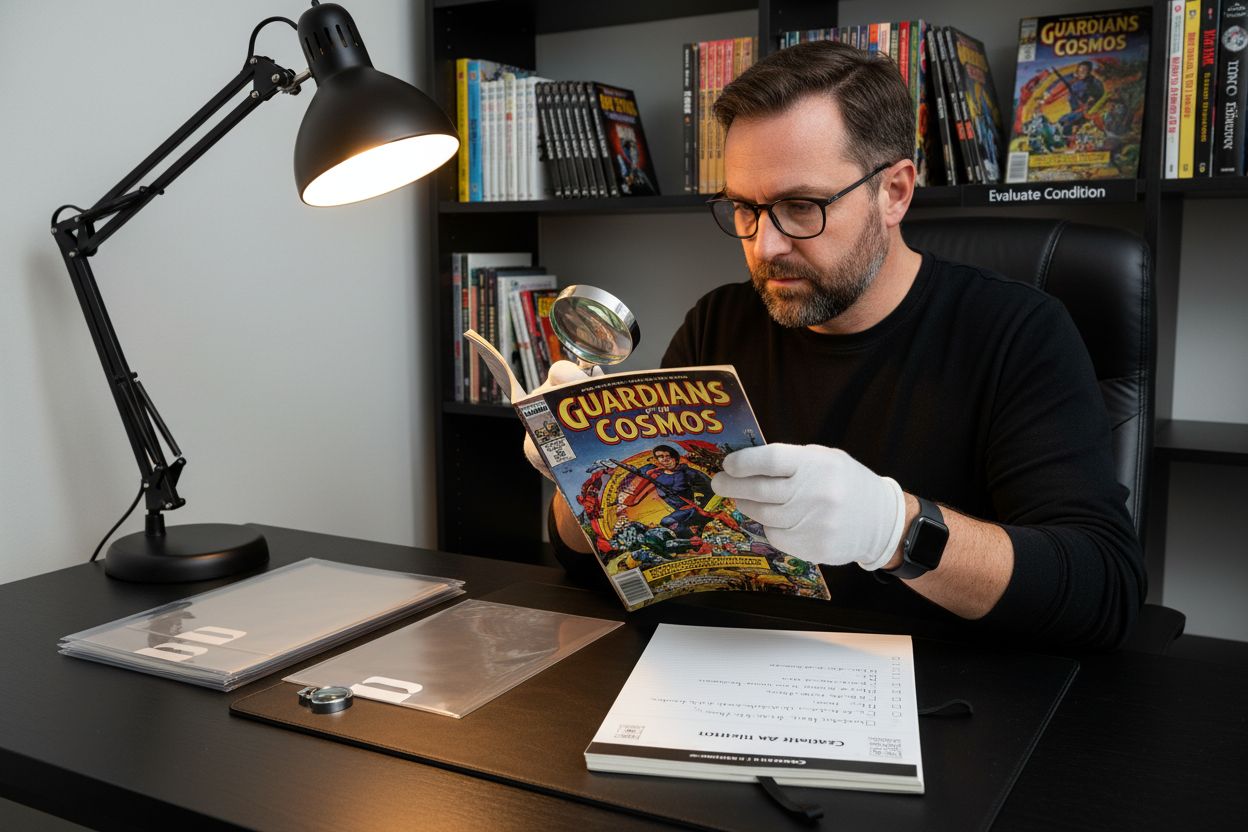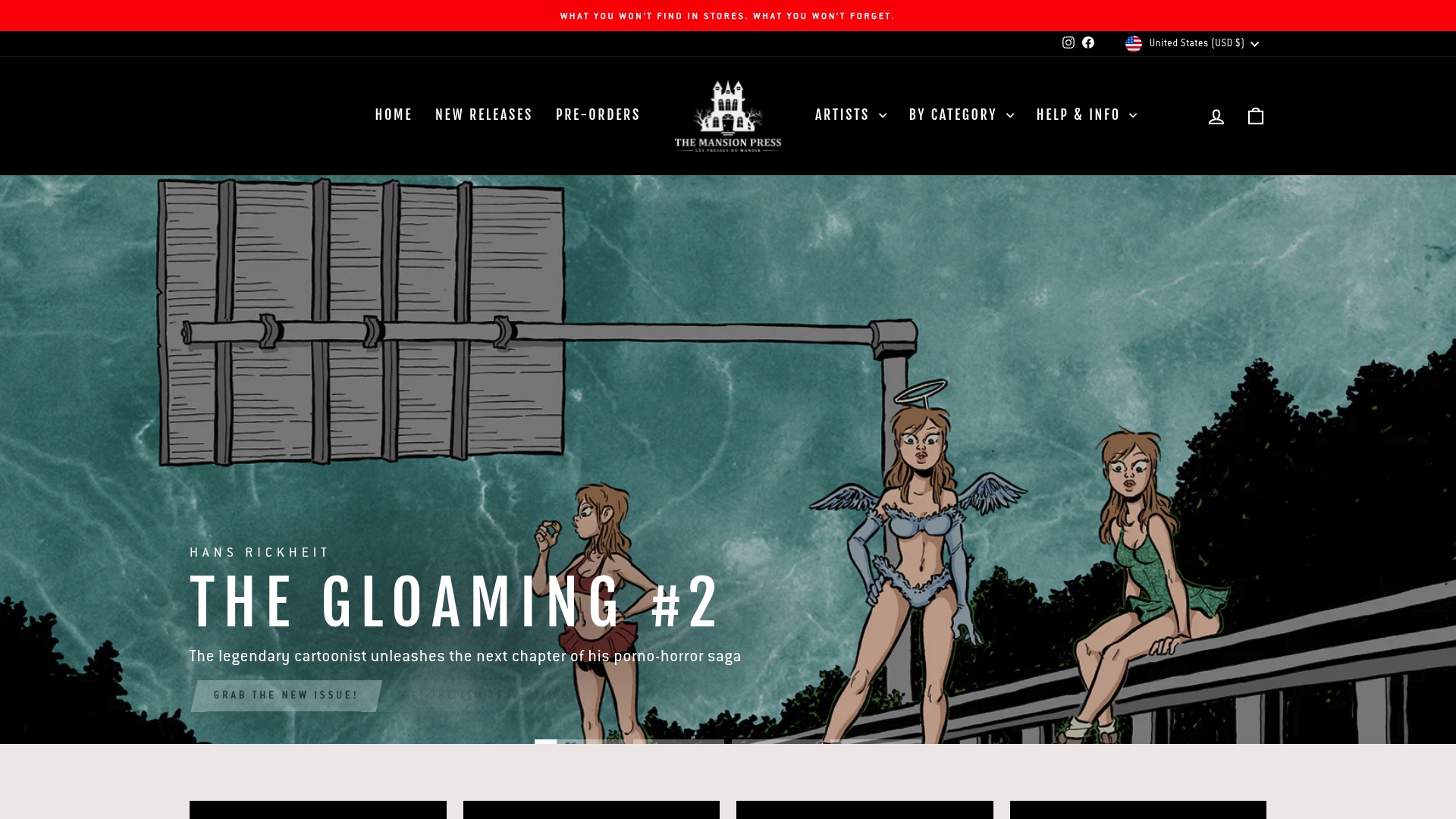Master Investing in Graphic Novels for Future Gains
People are pouring serious cash into graphic novels and not just for the love of comics. Some first edition superhero issues have jumped in value by over 500% in the last ten years. That might sound like pure luck or just a geeky trend. The real difference comes from those who treat their collections like investment portfolios, blending art and strategy in ways most collectors overlook.
Table of Contents
- Step 1: Research Graphic Novel Trends And Values
- Step 2: Identify Target Genres And Artists
- Step 3: Evaluate Condition And Authenticity
- Step 4: Set A Budget And Investment Strategy
- Step 5: Purchase And Secure Your Collection
- Step 6: Monitor And Reassess Investment Value
Quick Summary
| Key Point | Explanation |
|---|---|
| 1. Conduct thorough market research | Analyze sales trends and pricing to spot potential high-value graphic novels before they gain mainstream attention. |
| 2. Focus on specific genres and artists | Invest in popular genres like superheroes and emerging independent artists to maximize return potential. |
| 3. Evaluate condition and authenticity | Assess quality using professional grading tools to ensure investment value and marketability. |
| 4. Establish a clear budget and strategy | Define your investment limits and categorize spending to treat graphic novels as part of a serious portfolio. |
| 5. Continuously monitor market trends | Regularly track market fluctuations and sales data to reassess your collection’s value and make informed decisions. |
Step 1: Research Graphic Novel Trends and Values
Successful investing in graphic novels begins with thorough market research. This critical first step helps collectors and investors understand the complex landscape of graphic novel valuation, enabling smarter purchasing decisions. The goal is to develop a keen eye for identifying potential high-value comic book investments before they become mainstream.
Market Research Strategies
Start by tracking sales data and market trends across multiple platforms. Online auction sites like Heritage Auctions provide valuable historical sales information for rare and collectible graphic novels. Pay close attention to recent sale prices for first editions, limited prints, and works by renowned artists or writers. Some collectors focus on specific genres or creators who consistently generate significant market interest.
Understand that graphic novel value isn’t just about age or rarity. Key valuation factors include:
- Condition of the graphic novel (mint, near mint, good)
- Significance of the publication (first appearance, landmark storyline)
- Artist or writer reputation
- Cultural impact and historical importance
- Print run size and scarcity
Connect with comic book collector communities and forums to gain insider knowledge. Websites like Comic Book Realm and specialized subreddits offer real-time discussions about emerging trends and potential investment opportunities. Experienced collectors often share insights about upcoming artists, limited edition releases, and market movements that aren’t immediately visible to casual investors.
Utilize digital tracking tools and price guides to monitor market fluctuations. Professional resources like Overstreet Price Guide provide comprehensive valuation information across different comic book and graphic novel categories. These guides help investors understand historical pricing trends and make informed predictions about future value appreciation.
Develop a systematic approach to research. Set aside dedicated time each week to review market trends, follow artist developments, and track sales data. The most successful graphic novel investors treat their collection as a serious investment portfolio, continuously learning and adapting to market changes.
Step 2: Identify Target Genres and Artists
Navigating the graphic novel investment landscape requires a strategic approach to selecting genres and artists with proven or promising investment potential. This step moves beyond general market research to develop a focused collection strategy that maximizes potential returns.
Exploring Investment-Worthy Genres
Not all graphic novels are created equal when it comes to investment value. Science fiction, superhero narratives, and independent graphic novels often represent the most promising investment categories. Superhero comics from major publishers like Marvel and DC have historically demonstrated strong appreciation, particularly issues featuring first character appearances or significant storyline developments.
Independent and alternative graphic novels present unique investment opportunities. Artists and writers who push narrative boundaries often create works that become highly collectible. Pay attention to emerging talents recognized by industry awards like the Eisner Awards. Comic Book Resource provides excellent coverage of rising artists and critically acclaimed works that might become future valuable collectibles.
Artist and Creator Selection Criteria
Develop a systematic approach to identifying promising artists. Look for creators with these characteristics:
- Consistent critical acclaim
- Growing fan base
- Unique storytelling or artistic style
- Multiple published works
- Recognition from industry awards
- Cross-media potential (adaptations to film or television)
Network with comic book store owners and experienced collectors who can provide insights into emerging talents. Local comic shops and online collector forums often have early information about artists poised for significant breakthroughs. Some investors maintain relationships with specialized comic book stores that offer pre-order opportunities for limited edition prints or first runs.
Consider diversifying your investment across different genres and artists. While superhero comics remain a stable investment, alternative and independent graphic novels can offer unexpected value appreciation. Experimental works by critically acclaimed artists like Chris Ware or Marjane Satrapi demonstrate how graphic novels can transcend traditional comic book markets.
Track artist careers meticulously. Follow their social media, monitor their publications, and watch for significant career milestones. An artist’s trajectory can significantly impact the future value of their early works. Successful graphic novel investors treat this process like tracking emerging stock market performers, always looking for the next breakthrough talent.
Step 3: Evaluate Condition and Authenticity
Authenticity and condition are paramount when investing in graphic novels. This critical step separates serious collectors from casual buyers, directly impacting the potential value and marketability of your investment. Understanding how to thoroughly assess a graphic novel’s quality requires specialized knowledge and careful examination.
Condition Assessment Techniques
Begin by acquiring professional grading tools and understanding industry standard grading scales. Invest in high-quality white cotton gloves to prevent oil and dirt transfer when handling valuable graphic novels. Professional grading involves examining multiple physical characteristics, including page integrity, spine condition, cover quality, and potential restoration work.
Learn to recognize subtle indicators of graphic novel condition. Key evaluation points include:
- Spine integrity and alignment
- Page discoloration or yellowing
- Cover wear and corner damage
- Presence of original protective sleeves
- Moisture or environmental damage signs
Authenticity requires more than visual inspection. Professional Comic Book Grading Services offer comprehensive authentication and grading processes that provide official certification. These services use advanced techniques to verify originality and assess condition with microscopic precision. While professional grading comes with a fee, the added value and credibility can significantly impact potential resale prices.
Develop a systematic approach to examination. Use consistent lighting conditions and a clean, flat surface when inspecting graphic novels. Magnifying glasses and bright, indirect lighting help reveal subtle imperfections invisible to the naked eye. Consider investing in archival-quality storage materials that protect your collection from environmental degradation.
Understand that restoration can dramatically impact value.
 Some collectors prefer completely original copies, while others accept professional restoration. Learn to distinguish between different restoration techniques and their potential impact on market value. Minor restoration might preserve a graphic novel’s collectibility, while extensive alterations could significantly reduce its worth.
Some collectors prefer completely original copies, while others accept professional restoration. Learn to distinguish between different restoration techniques and their potential impact on market value. Minor restoration might preserve a graphic novel’s collectibility, while extensive alterations could significantly reduce its worth.
Build relationships with experienced collectors and reputable comic book dealers who can provide additional insights. Their expertise can help you develop a refined eye for assessing graphic novel condition and authenticity.
Below is a checklist summarizing important steps for evaluating the condition and authenticity of a graphic novel before purchase.
| Step | What to Do | Why It Matters |
|---|---|---|
| Use white cotton gloves | Handle the novel carefully to avoid damage | Preserves quality and avoids fingerprint stains |
| Inspect spine and pages | Check integrity, discoloration, and wear | Indicates overall condition and value impact |
| Check cover and corners | Look for wear, tears, or corner dings | Key factors in grading and resale potential |
| Look for restoration signs | Identify any professional or amateur repairs | Affects original value and collector interest |
| Verify authenticity | Seek professional grading or certification | Confirms originality and boosts marketability |
| Use proper lighting and magnification | Inspect under bright, indirect light, and with a magnifying glass | Reveals imperfections not visible to the naked eye |
| Store with archival materials | Use acid-free sleeves and proper storage | Protects from environmental damage and long-term degradation |
 Attend comic conventions, join specialized collector forums, and continuously educate yourself about emerging authentication techniques and market standards.
Attend comic conventions, join specialized collector forums, and continuously educate yourself about emerging authentication techniques and market standards.
Step 4: Set a Budget and Investment Strategy
Developing a comprehensive budget and investment strategy transforms graphic novel collecting from a hobby into a structured financial approach. This crucial step requires careful planning, realistic expectations, and a disciplined methodology for building your collection.
Financial Planning for Graphic Novel Investments
Begin by establishing a clear financial framework that separates your graphic novel investment budget from other personal expenses. Recommended initial investment ranges typically start between $500 to $2,000 for serious collectors, allowing enough capital to acquire meaningful pieces without overwhelming your personal finances. Professional investors suggest allocating no more than 5-10% of your discretionary investment portfolio to collectible assets like graphic novels.
Create a detailed tracking system for your investments. Use spreadsheet software to monitor:
- Purchase prices
- Current market values
- Estimated appreciation
- Maintenance and storage costs
- Potential sale value
Research from Kovels Antiques indicates that successful collectors approach graphic novel investments with the same rigor as traditional stock market investments. Diversification becomes key strategy, spreading risk across different genres, artists, and publication eras. Avoid putting all resources into a single type of graphic novel or artist.
Investment Risk Management
Understand that graphic novel investments carry inherent market volatility. Some collectors focus on blue-chip investments like first editions of well-established series, while others pursue emerging artists with potential breakthrough value. Balance your portfolio between stable, proven collectibles and more speculative emerging works.
Consider additional costs beyond purchase price. Professional storage, insurance, and potential restoration expenses can significantly impact your overall investment strategy. Climate-controlled storage and specialized insurance for collectibles might seem unnecessary initially but protect long-term value.
Establish clear personal guidelines for purchasing. Set strict rules about maximum purchase prices, required condition standards, and total collection size. Some investors use a disciplined approach of purchasing only one or two high-quality pieces annually, focusing on quality over quantity. Regular market research and price guide consultations help refine your strategy, ensuring your graphic novel collection remains a strategic financial asset rather than an uncontrolled expense.
Here is a comparison table outlining potential investment strategies, balancing conservative and speculative approaches as discussed in the content.
| Strategy Type | Focus | Advantages | Considerations |
|---|---|---|---|
| Conservative | Blue-chip first editions, established series | Stable appreciation, lower risk | Higher initial investment required |
| Diversified | Mix of genres, artists, and publication eras | Spreads risk, increases discovery chances | Requires deeper research and tracking |
| Speculative | Emerging artists, independent works | Potential for high reward, low entry cost | Higher risk, market volatility |
| Quality Focus | Few high-grade, authenticated novels | Maximizes value per piece | Slower collection growth |
| Quantity Focus | Larger, broader collection | Greater potential for surprise finds | Increased storage, maintenance, and risk of lower average quality |
Step 5: Purchase and Secure Your Collection
Transitioning from research and planning to actual acquisition requires strategic decision making and careful execution. Purchasing graphic novels is more than a simple transaction it represents a calculated investment in cultural artifacts with potential long-term value appreciation.
Purchasing Strategies
Begin by establishing trusted purchasing channels. Reputable comic book stores, specialized online marketplaces, and authenticated auction platforms provide the most reliable sources for high-quality graphic novels. Prioritize sellers with comprehensive documentation and transparent grading systems. Online platforms like Heritage Auctions offer professional verification and detailed condition reports that protect investors from potential misrepresentations.
Develop a systematic approach to purchasing that includes comprehensive verification steps:
- Request detailed condition photographs
- Verify seller authenticity and reputation
- Confirm original packaging and documentation
- Understand return and authentication policies
- Request professional grading certificates when possible
Securing your collection goes beyond initial purchase. Professional archival storage becomes critical for maintaining investment value.
Use acid-free archival sleeves, maintain consistent temperature and humidity levels, and store graphic novels vertically to prevent spine damage. Specialized storage solutions protect your investment from environmental degradation.
Implement a robust documentation system for your collection. Create digital and physical records that include purchase details, condition reports, authentication certificates, and estimated market values. Professional collectors maintain detailed spreadsheets tracking each acquisition, including purchase price, current estimated value, and potential appreciation trends.
Consider purchasing insurance specifically designed for collectible assets. Many standard homeowner policies provide inadequate coverage for specialized collections. Specialized collectibles insurance offers comprehensive protection against damage, theft, and potential loss. Research providers who understand the unique value of graphic novel collections and can provide tailored coverage.
Remember that each purchase represents more than a financial transaction. You are becoming a curator of cultural artifacts, preserving artistic narratives and potential future historical significance. Approach each acquisition with patience, thorough research, and a long-term perspective that values both monetary potential and artistic appreciation.
Step 6: Monitor and Reassess Investment Value
Successful graphic novel investing requires continuous monitoring and strategic reassessment. This ongoing process transforms your collection from a static asset into a dynamic investment portfolio that can adapt to market changes and emerging opportunities.
Tracking Market Dynamics
Systematic market tracking becomes your primary tool for maintaining investment value. Utilize multiple information sources to build a comprehensive understanding of market trends. Professional collectors develop a routine of regularly checking auction results, tracking sales data, and monitoring industry publications that provide insights into graphic novel valuations.
Establish a comprehensive tracking system that includes:
- Quarterly market value assessments
- Tracking sales of similar graphic novels
- Monitoring artist and genre market movements
- Recording auction and online marketplace prices
- Documenting collection appreciation rates
Comic Book Realm offers extensive databases and tracking tools that help investors understand market fluctuations. Professional investors recommend allocating at least two to four hours monthly for detailed market research, comparing current collection values against previous assessments.
Understand that graphic novel investments are influenced by multiple complex factors. Cultural trends, media adaptations, artist recognition, and broader collectibles market dynamics can dramatically impact value. An independent graphic novel might suddenly appreciate in value after a successful film adaptation or when its creator wins a prestigious award.
Develop a disciplined approach to portfolio management. Set clear criteria for holding or selling graphic novels based on predetermined performance metrics. Some investors establish threshold rules, such as selling when a piece appreciates 50% or holding long-term for potential significant value increase. Regular reassessment allows you to make informed decisions about expanding, maintaining, or strategically selling parts of your collection.
Consider consulting with professional appraisers or joining specialized collector networks that provide deeper market insights. These professionals can offer nuanced perspectives on potential future value trajectories that might not be immediately apparent. Remember that successful investing requires patience, continuous learning, and a willingness to adapt your strategy based on evolving market conditions.
Take Your Graphic Novel Investment Strategy Further
You already know that researching trends, evaluating condition, and securing authentic collectible graphic novels are critical steps in building a profitable collection. Yet, one major challenge remains: sourcing rare, original, and limited editions from trustworthy sellers. Finding unique works by independent artists before they surge in demand can feel overwhelming, especially when you want assurance on quality, authenticity, and future value. If you are ready to move from research to real action, you need direct access to the kind of exclusive editions and artist collaborations highlighted in your investment goals.

Visit The Mansion Press today and explore a carefully curated selection of artbooks, comics, and collector’s editions. Discover upcoming releases through pre-order options, browse collections by breakthrough artists, and invest confidently in original works you will not find in traditional retail outlets. Grow your portfolio with items that combine artistic significance with investment potential—start building your next-level graphic novel collection right now at The Mansion Press website.
Frequently Asked Questions
What are the key factors that determine the value of graphic novels?
Key valuation factors for graphic novels include condition (mint, near mint, good), significance of publication (first appearances, landmark storylines), reputation of the artist or writer, cultural impact, and print run size.
How can I effectively track graphic novel market trends?
Utilize resources like auction sites, price guides, and collector forums to monitor market changes. Establish a routine to check sales data, track artist developments, and analyze sales of similar graphic novels for accurate valuation assessments.
What steps should I take to evaluate the condition of a graphic novel?
To evaluate condition, examine spine integrity, page quality, cover wear, and any signs of moisture damage. Professional grading services can also provide an official assessment of the graphic novel’s authenticity and condition.
How can I develop a strategic investment plan for graphic novels?
Start by setting a clear budget for graphic novel investments, typically between $500 to $2,000 for serious collectors. Diversify your collection across genres and artists while keeping detailed records of your investments, including purchase prices and market values.

